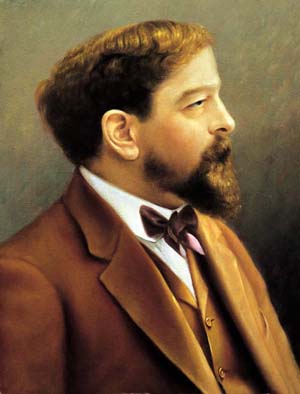Claude Debussy
 From Conservapedia
From Conservapedia (Achille) Claude Debussy (1862 - 1918) was a French composer; and the founder of Impressionism in music. His music was the tonal equivalent of the working in light of Monet; and the word pictures of the “Symbolist” school of writers like Verlaine, Baudelaire, Mallarme and others - who suggested rather than stated - many of whose works he set to music in songs that grace the repertoire today. But whilst it seems he spurned the Classics and the Romantics, his music is really a refinement of them, and a way forward.
It can be said that his “Prelude to the Afternoon of a Faun” (1894) is the first musical work that truly belongs to the Twentieth Century; and his opera, Pelléas and Mélisande (started 1893, but not completed until 1902), charted new operatic waters – eschewing the aria and the big scene; instead using almost conversational understatement in front of sublimely delicate orchestration, and using a sound stage to suggest the drama and ultimate tragedy.
In his younger days he had studied in Rome as a winner of the Prix de Rome, and had twice visited Wagner’s Bayreuth (which is apparent in some early works such as certain songs and the String Quartet.) In 1889 he heard some Balinese music in Paris, and this was to color many of his works. (He was not alone – the Balinese gamelan features in the music of a number of European composers of the early Twentieth Century. Ravel and Percy Grainger are two.)
Debussy’s main output consists of orchestral pieces, piano works and songs. (He did work on other operatic projects but did not finish them.) His orchestral pieces are mainly descriptive (at least suggestive) with the most notable being "La Mer" - however a number of others: “Sacred and Profane Dances”, “Sirens”, “Images”, “Nuages” “Iberia”, and his ballet, “Jeux”, are frequently enjoyed for their tonal colour and range of orchestral expression. Later stage works, such as “The Martyrdom of St, Sebastian” were completed by others.
Debussy’s piano works are unique in their range of expression, and delicacy of tone. He was one of the great writers for the instrument. He wrote two sets of preludes and a set of twelve etudes that rank with Chopin’s as pinnacles of the art. Within these and other sets, are individual pieces that have escaped the confines of “art” and are heard with pleasure by many who have never heard of their creator: “Clair de Lune”, Golliwog’s Cakewalk”, “The Girl with the Flaxen Hair”, “The Sunken Cathedral”.
His many songs hold their place in the line of French “Melodie” running from Faure to Ravel and later. They are usually to words of the “Symbolist” poets, supported by delicate and sympathetic accompaniment.
His chamber works must be mentioned. As well as the early quartet, and an even more youthful piano trio, he wrote sonatas for violin, for cello and for the interesting combination of flute, viola and harp. A short piece for solo flute, “Syrinx”, is frequently heard.
Claude Debussy died before his time, of cancer. He had planned the writing of six sonatas. It is a tragedy they cannot all be heard.
See also[edit]
Reference: http://www.wqxr.com/cgi-bin/iowa/cla/learning/grove.html?search=debussy&submit=Search+Grove
Categories: [Composers] [Pianists]
↧ Download as ZWI file | Last modified: 03/02/2023 10:17:35 | 18 views
☰ Source: https://www.conservapedia.com/Claude_Debussy | License: CC BY-SA 3.0
 ZWI signed:
ZWI signed:
 KSF
KSF